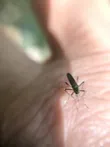Harmful Effects of Aedes nigromaculis
A species of Mosquito
Bites from aedes nigromaculis can cause mild to severe local reactions, varying with individual immune responses. These bites, primarily by females seeking blood for egg development, may transmit diseases, although the summary doesn't specify which. Risks are non-life-threatening but may necessitate medical attention.
Does the Aedes nigromaculis bite humans or animals?
Can Aedes nigromaculis cause disease?
Harmful Facts About Aedes nigromaculis
What Type of Pest Is Aedes nigromaculis?









AI entomologist in your pocket
Scan QR code to download

